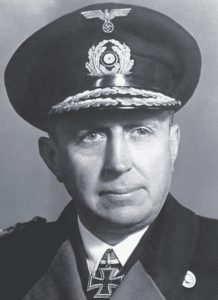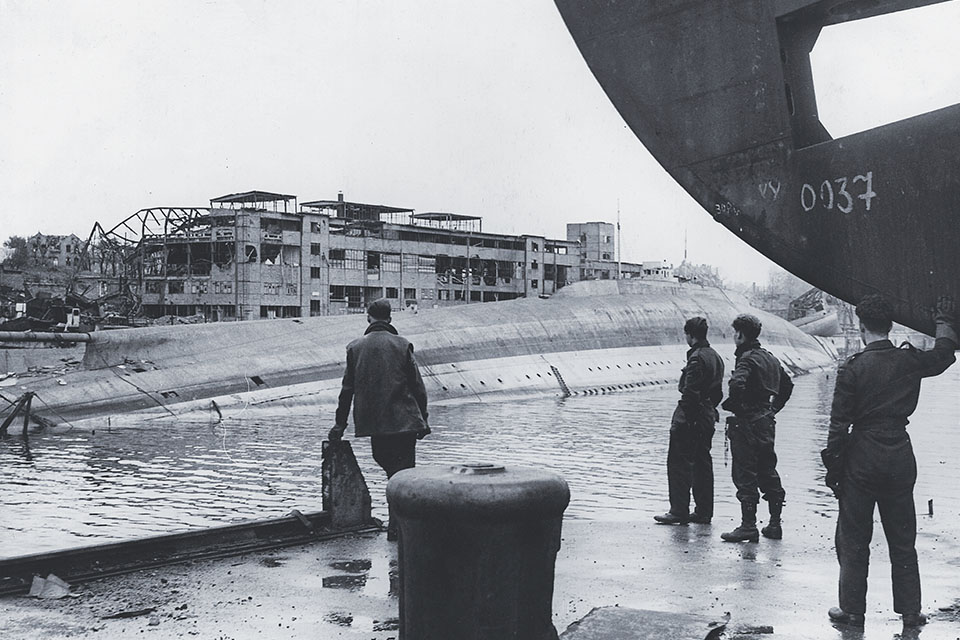CAPTAIN EDWARD FEGAN KNEW THAT THE EIGHT 6-INCH GUNS of his thin-skinned armed merchant cruiser Jervis Bay stood no chance against the approaching German pocket battleship. Jervis Bay, converted from a 14,164-ton liner, was escorting 37 cargo ships across the North Atlantic Ocean to Britain. Without enough time to disperse, all of them were defenseless prey.
And so, when the German warship opened fire at 17,000 yards, Fegen didn’t hesitate to engage it. While its 11-inch guns demolished Jervis Bay, the pocket battleship’s secondary 5.9-inch guns flailed at the scattering merchantmen, badly damaging the tanker San Demetrio and the cargo liner Rangitiki before they escaped. Inevitably Jervis Bay sank, taking Fegen and 179 of his crew with it; 65 survivors were later rescued by the Swedish freighter Stureholm. For his valorous sacrifice in the face of impossible odds, Fegen was posthumously awarded the Victoria Cross.
While many Britons are well versed in Jervis Bay’s heroic stand on November 5, 1940, fewer know that its adversary’s exploits were just beginning.
Launched at Wilhelmshaven, Germany, on April 1, 1933, Admiral Scheer was one of three capital ships that Germany built under the 11-inch gun and 10,000-ton restrictions imposed on it by the Washington Naval Treaty of 1922. The first, Deutschland, actually exceeded the limit by 1,700 tons, but the British Admiralty failed to question the ship’s weight when it was launched in 1931. Essentially designed to outgun anything it could not outrun at its maximum speed of 26 knots, Deutschland was classified by the German navy as a panzerschiff (armored ship), but its heavy armament led the British to dub it a “pocket battleship.”
By the time Deutschland and its improved sisters, Admiral Graf Spee and Admiral Scheer (named for German naval heroes Maximilian von Spee and Reinhard Scheer), were launched, Adolf Hitler had become chancellor of Germany and renounced the Washington Naval Treaty, rendering the ships’ tonnage moot. Scheer was 616 3/4 feet long, displacing 11,200 tons empty and 16,200 loaded; four MAN diesel engines, totaling 56,800 horsepower, drove its two propellers. Its 4-inch waterline armor belt was bolstered by 11/2 inches of internal armor. Two triple 11-inch gun turrets were complemented by eight 5.9-inch, six 4.1-inch, eight 37mm, and ten 20mm antiaircraft guns. It also mounted two quadruple torpedo tubes, and two aircraft could be launched from its single catapult. Its crew totaled 1,150 men.
Commissioned on November 12, 1934, Scheer entered service during the Spanish Civil War, evacuating German refugees, reporting Soviet ships bringing arms to the Republicans in violation of the London Non-intervention Agreement, and escorting German shipments to the Nationalists, in equally flagrant violation of the agreement.
The outbreak of World War II found the Kriegsmarine in no position to challenge Britain’s Royal Navy. Instead, Grand Admiral Erich Raeder sought to disrupt Allied merchant shipping with his submarines, regular warships, and disguised auxiliary cruisers, stretching Allied naval resources as far as possible. His strategy committed his ships to the hazardous balancing act of maintaining a profile that was high enough to harass the enemy, through attacks on convoys or lone cargo ships, yet low enough to avoid being hunted down.
For the Admiral Scheer, World War II began on September 4, 1939, when Bristol Blenheims of No. 107 Squadron, Royal Air Force, bombed it in Wilhelmshaven. While it was being repaired, Deutschland sank two merchantmen in the North Atlantic and Graf Spee sank nine in the South Atlantic and Indian Oceans. But on December 13, Graf Spee, encountering and engaging three British cruisers off Uruguay, sustained enough damage to put into Montevideo. There, gathering British forces persuaded Captain Hans Langsdorff to scuttle his ship on the 17th. Langsdorff, feeling disgraced, committed suicide three days later. In the wake of Graf Spee’s dramatic demise, Hitler ordered Deutschland to be rechristened Lützow so as not to risk losing a ship bearing the country’s name.

On October 14, 1940, Hitler reluctantly permitted Raeder to send Scheer into the Atlantic with Captain Theodor Krancke, a former commandant of the naval college and a staff officer in Raeder’s Oberkommando der Kriegs- marine, at the helm. The critical task of refueling Scheer at sea would be performed at designated rendezvous by the oiler Nordmark.
Scheer left the Baltic seaport of Gotenhafen (present-day Gdynia, Poland) on the coast of Prussia on October 23, and six days later it steamed north into Arctic waters to avoid detection by British aircraft. The next day it turned 350 degrees and headed south through hurricane-force winds and heavy seas that swept two men overboard.
Soon after Scheer slipped through the Denmark Strait on November 1, the Kriegsmarine’s Beobachtungsdienst (observation service), or B-Dienst, which had broken the British naval codes in 1936, informed Krancke that a large British convoy, HX-84, had left Halifax, Nova Scotia, on October 27. On the morning of November 5 Scheer launched one of its Arado 196 reconnaissance floatplanes, whose pilot reported eight ships approaching. That afternoon Scheer encountered the SS Mopan, a 7,900-ton banana boat, and sank it with a 4.1-inch shell below the waterline for its first kill.
Just then a 38-ship convoy appeared over the horizon. Krancke’s hopes of a quick and easy slaughter were foiled by the spoiling action put up by Captain Fegen and Jervis Bay, though in the six hours that followed, Scheer managed to overtake and sink five ships totaling 52,884 tons.
In reaction to Scheer’s attack on HX-84, the British recalled two other convoys outbound from Halifax, dispatched the battleships Nelson and Rodney to block the passage between Iceland and Denmark’s Faero Islands and sent three battlecruisers, along with three light cruisers, to patrol the approaches to the Bay of Biscay. The Admiralty also decreed that, from then on, any large convoy crossing the North Atlantic would have to have at least one battleship among its escort.
Krancke, who was kept abreast of those developments by B-Dienst, should have been concerned about his prospects of safely returning home. In truth, though, he had other plans.
Turning south, Krancke headed farther into the Atlantic. On November 24, after refueling with Nordmark near the Canary Islands, Scheer encountered the refrigeration ship Port Hobart, which Krancke allowed to transmit a raider distress signal, hoping the British would send a warship or two to that remote location after he’d moved on. Observing international prize rules regarding the treatment of personnel aboard captured vessels, he brought Port Hobart’s crew and passengers aboard.
A week later, 900 miles off the coast of Gambia, Scheer’s Ar 196 sighted the 6,242-ton British cargo ship Tribesman. Not wishing to be reported this time, Krancke crept up at night and shot the vessel’s radio aerials away before sinking it. At that point, Scheer’s engines needed an overhaul, so Krancke alternately relied on one while his engineers worked on the other, at a reduced speed of 22 knots. On December 14 Scheer again met Nordmark and offloaded its 150 prisoners.
Three days later Krancke learned that Raeder had dispatched the heavy cruiser Admiral Hipper into the North Atlantic. Later that day he encountered the refrigeration ship Duquesa. Aiming to divert British attention from Hipper, he allowed Duquesa to get off distress calls before capturing it. Although its coal-burning engine made Duquesa a poor prize for the diesel-powered Scheer, its huge stocks of beef, mutton, tinned meat, and bacon, along with 604 cases of eggs, were another matter, especially with Christmas just around the corner, so Krancke opted to keep the ship afloat for the time being. On December 22 Scheer met Nordmark, which took on the provisions while Krancke transferred his female prisoners to the more commodious Duquesa.
Meanwhile, Hipper attacked Convoy WS-5A, only to be driven off by three British warships. On December 27 it returned to Brest, France, empty handed. The Royal Navy’s decision to have big ships escort the convoys was beginning to pay off.
At the same time, Britain mounted a concerted effort to destroy Scheer. Responding to Duquesa’s distress call, it dispatched seven ships to search for the raider.
As Scheer continued south, Krancke’s crew celebrated Christmas Eve with beef, beer, walnuts, and cigarettes, all from Duquesa. On Christmas morning, the auxiliary cruiser Thor and the German freighter Eurofeld joined the impromptu holiday gathering and Krancke conferred with the Thor’s captain, Otto Kähler. The Kriegsmarine’s general staff had suggested they operate together, but the two skippers agreed that was not feasible—the panzerschiff’s distinctive silhouette would compromise Thor’s stealth advantage, while the slower Thor would cancel Scheer’s speed asset.
On December 29, five ships flying the German flag—Scheer, Nordmark, Eurofeld, Thor, and Storstad, a captured Norwegian tanker—met at Andalusien, a rendezvous point north of Tristan de Cunha in the middle of the South Atlantic. After a short, fruitless raiding patrol, Scheer and Thor rejoined Nordmark and Eurofeld on December 31, and while Scheer’s Ar 196 crew kept an eye out for British party crashers, the German crews signaled New Years’ greetings to one another 6,000 miles from home, in the middle of what was virtually an Allied lake. At that point, three more German auxiliary cruisers—Pinguin, Kormoran, and Atlantis—had broken out, and Nordmark was also tending to three Italian submarines in the South Atlantic. For the Kriegsmarine, 1941 looked like a promising year.
With its fuel supply emptied, Storstad was loaded with prisoners and sent to France on January 2. On January 17, striking north for the Cape Town–Freetown route off West Africa, Scheer captured another Norwegian tanker, Sande-fjord. On January 20 it encountered two ships. Krancke approached the Dutch Barneveld bows-on, with two guns raised and one depressed to resemble a British cruiser, until he was close enough to seize it without firing a shot. Then he sent a boarding party by motorboat to commandeer the second, the British Stanpark. “It’s all right, lads,” a German officer sarcastically announced as he came aboard the ship. “The navy’s here.” After their cargoes were noted down and their crews evacuated, both ships were sunk.
On January 24, Scheer met and replenished from Nordmark and Duquesa and dispatched 250 prisoners to Bordeaux aboard Sandefjord. Four days later Krancke decided to try his luck in the Indian Ocean. After a vain sweep along the active shipping route between Durban, South Africa, and Perth, Australia, Scheer met the supply ship Tannenfels, refueled from the captured tanker Ketty Brovig north of Madagascar, and headed west.
By February 20 Scheer was off the Seychelles when its floatplane spotted a ship. Using a British signaling technique to mask its nationality, Scheer nabbed British Advocate, carrying oil and petroleum. While a prize crew came aboard with orders to rendezvous with the raider Atlantis, the Ar 196 reported another sighting. That night, Scheer overhauled the Greek steamer Grigorios C, a neutral ship on its way from New York to Athens, ostensibly with a cargo of material for the Red Cross. But Krancke was suspicious from the get-go and ordered an inspection of its cargo, which turned out to contain machine gun parts and other war material. “Very interesting,” Krancke told his men. “So it’s a case of ‘Beware of the Greeks’ again.” They took 27 prisoners from the Grigorios and sent the ship and its contraband to the ocean floor.

On the evening of February 21, the Ar 196 sighted another ship. Scheer investigated, again with two guns raised to impersonate a British cruiser. The vessel’s sides bore colors of the then neutral United States, but Krancke blinkered a message: “Stop at once. Do not force me to open fire. You are behaving very suspiciously.” “So are you,” the freighter signaled back. “You look like a German to me.” As Scheer opened fire, its wireless crew picked up a transmission: “Canadian Cruiser in 6 degrees 36 minutes south, 47 degrees 18 minutes east, under attack by battle cruiser.”
A burst of 37mm gunfire at the bridge persuaded Canadian Cruiser’s captain to surrender, but its distress call came at a fortunate time for the British. WS-5B, a 20-ship convoy escorted by the cruisers Australia and Emerald, had left Durban on February 15 and arrived off Mombasa on the 21st. Meanwhile, the cruisers Canberra, Shropshire, and Hawkins fanned out looking for Scheer; Force V, composed of the aircraft carrier Hermes and light cruisers Glasgow, Emerald, and Cape Town, soon joined them. Captain Harold Hickling on the Glasgow, 400 miles west of Scheer, heard Canadian Cruiser’s signal and turned southeast.
For the Germans, the Indian Ocean was shrinking and time was running out.
On February 22, Scheer caught one more victim, the Dutch steamer Rantau Bandjang, leaving one of its men dead and five wounded. Glasgow was only 140 miles away when Hickling picked up Rantau Bandjang’s distress call and launched a Supermarine Walrus flying boat, which spotted the pocket battleship just before noon. Abandoning any thoughts of waylaying convoy WS-5B, Krancke turned east, hoping to mislead the Walrus’s crew until it broke contact. The aircraft finally departed at 12:48.
At 2 p.m. Glasgow, now 80 miles away from Scheer, launched its refueled Walrus again, while Hickling relayed what he knew of the enemy’s whereabouts to Vice Admiral Ralph Leatham at the East Indies station. At that point, however, deteriorating weather reduced visibility to three miles. Scheer, meanwhile, had reversed course and was steaming west. Some hours later, Glasgow’s fuel ran low, compelling Hickling to make for the isle of Mauritius to replenish. In his memoir, Sailor at Sea, Hickling later ascribed the frustrating outcome of his pursuit to “Scheer bad luck.”
The German marauder, on the other hand, seemed to lead a charmed life. After meeting British Advocate, whose prize crew Krancke instructed to take the captured vessel to France, Scheer managed to evade the closing British dragnet. The heavy cruiser Cornwall crossed the German’s path twice without either captain knowing it. At one juncture, Cornwall stopped the Madagascar-bound Vichy French transport Ville de Majunga for questioning; had it not done so, its path and Scheer’s might have crossed again.
Reentering the South Atlantic, Scheer met the supply ships Ermland and Nordmark on March 8. Two days later the supply ship Alsterufer arrived with 5.9-inch ammunition and spare parts for the Ar 196. The Germans were investing a lot in the effort to keep Scheer supplied and on the move.
Krancke now judged it time to quit while he was ahead rather than risk a reprise of the Graf Spee fiasco. On March 15 Scheer crossed the equator. The next day, it encountered the Kormoran and U-124, which carried the parts needed to repair the panzerschiff’s worn-out radar. On March 27, after two days prudently waiting for bad weather to envelop the Denmark Strait, Krancke took advantage of a new moon to slip through, evading light cruisers Fiji and Nigeria at the northern end.
On April 1, eight years to the day after it had been launched at Wilhelmshaven, Scheer triumphantly entered Kiel for an inspection and a welcome speech by Grand Admiral Raeder. Krancke received the Knight’s Cross and promotion to rear admiral. Forty of his crewmen were awarded the Iron Cross First Class and the rest the Iron Cross Second Class.
The jubilation was justified. In 161 days, Scheer had steamed 46,419 nautical miles through the Arctic, Atlantic, and Indian Oceans, sinking 16 merchant ships totaling 99,059 tons, as well as the AMC Jervis Bay—the best results ever achieved in one sortie by a regular surface warship of the Kriegsmarine. Scheer had demonstrated what a formidable raider a diesel-engine panzerschiff could be, and unlike the unfortunate Graf Spee, it had returned to boast about it.
Scheer’s homecoming capped a triumphant season for Germany’s High Seas Fleet, but its fortunes soon turned. On May 8 Cornwall made up for its failure to catch Scheer when it intercepted and sank the raider Pinguin. Then, on May 26, the Royal Navy sank Germany’s most powerful battleship, Bismarck. That led Hitler to issue an ill-defined order against “unnecessary risks” that deprived Raeder’s surface ships of the flexibility and scope—indeed, the initiative—they needed to operate effectively.
In the summer of 1942, on its only other raid, Scheer ventured into the Kara Sea, north of Siberia, to bombard Soviet polar settlements and installations. After sinking the armed icebreaker Aleksandr Sibiryakov on August 25, 1942, Scheer returned to Skjomanfjord, Norway. It served thereafter as a training ship until November 1944, when it bombarded advancing Soviet forces and evacuated troops and refugees along the Baltic Coast.
Bombed in Kiel by Avro Lancasters on the night of April 9–10, 1945, Scheer capsized with 32 of its crew dead, and after Germany’s surrender on May 8, it was buried where it had sunk under thousands of tons of rubble.
Krancke rose to head Navy Group Command West, headquartered in Paris, and was in charge of all warships, coastal artillery, antiaircraft guns, and other naval facilities along the Atlantic Coast when the Allies landed in Normandy on June 6, 1944. After the war he teamed with Jochen Brennecke to write a memoir, Pocket Battleship: The Story of the Admiral Scheer. He died in Wentorf, Germany, on June 18, 1973, at age 80.
Now a relative footnote in naval history, Admiral Scheer’s lone exploit of 1940–1941 remains a remarkable achievement. Unlike more famous colleagues such as Graf Spee, Bismarck, Scharnhorst, and Tirpitz, the last of the pocket battleships beat the odds and came home to die.
Jon Guttman is MHQ’s research director.
This article appears in the Autumn 2018 issue (Vol. 31, No. 1) of MHQ—The Quarterly Journal of Military History with the headline: The Marauder





